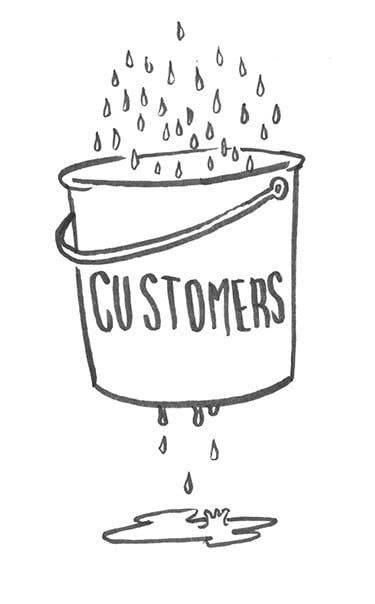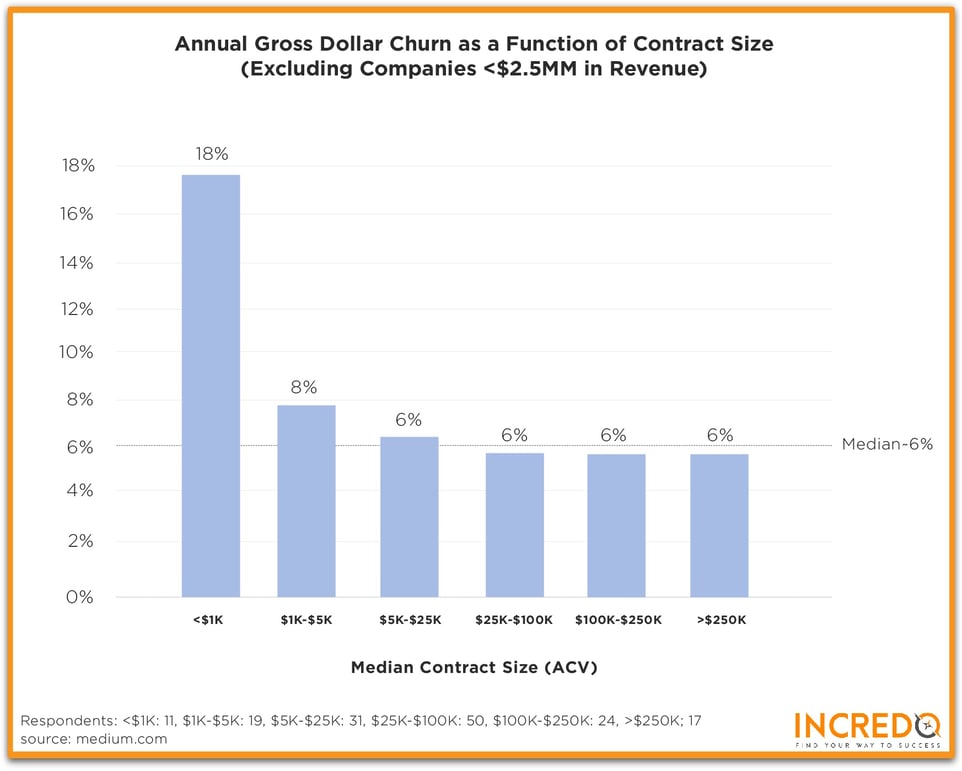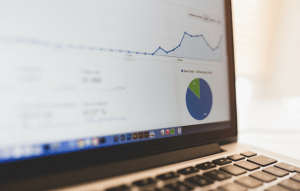SaaS Churn Rate Benchmark in 2021: Reasonable Customer Attrition Rate

SaaS Churn Rate Benchmark in 2021: Reasonable Customer Attrition Rate
Every SaaS entrepreneur, CEO, SaaS sales or marketing professional has at one time or another felt SaaS churn. And it hurts.
Churn, customer attrition, abandonment, turnover, whatever name you choose to label it. It means that your company is losing money and your customer retention efforts face trouble. However, to approach life realistically (as every business owner should), one should not be disappointed when they cannot take money from everybody’s pockets. The path to success in the business world is taking money from the right customers’ pockets: the customers that need what you provide.
If you are looking for a quick answer to the ideal rate of customer attrition, the answer is 0% churn. Yeah, uh, good luck with that…send us an email when that happens!
There is a purpose why this article prefaces “customer attrition rate” with the word “reasonable”. It is going to happen. But if you have a rate of customer defection offset by your revenue, then your business is manageable.
One of the greatest challenges for newer SaaS companies is figuring out how to not only get customers to try out your software, but to keep coming back for more. Even the established SaaS dominators have customer retention at the forefront of their priorities.
However, customer attrition expectations and benchmarks vary from industry to industry. It would be foolhardy to assume that a SaaS vendor of project management software would expect the same percentage of churn as a sales management software vendor, as each industry has varying degrees of competition, market saturation, and unique buyer personas.

(source: bplans.com)
Not all churn is created equal
Before we get into it today, we need to clear something up that confuses far too many SaaS professionals. Not all measurements of churn are created equal. What we mean is that churn of 5% monthly is not the same as 5% annually measured churn. It is important to pay attention to what units of time are referenced, as there is a lot of information out there on the topic of churn. Different sources for any number of reasons will measure churn with varying frequency. So make sure that you factor in the length of time over which churn is being referenced.
A 95% rate of annual customer retention is significantly more impressive than a 95% rate of monthly retained subscribers. So, make sure that you pay attention to the timeframe of measuring customer attrition. Because if you have 200 customers and lose 5% a year it’s losing 5% of 200 customers monthly.
In case you didn’t know…
A monthly churn rate of 5% equals and annual churn rate of 46%! So don’t be too impressed when a company boasts of their 1% monthly attrition rate… They are losing more customers a year than a company with an 8% annual rate of churn.
Churn will vary, regardless of specific industry, from time to time. However, depending on the new subscribers rate certain SaaS companies need be more concerned with their attrition than others. For example, if your rate of new subscribers is 10% annually, an annual churn rate of 5% is manageable. Your revenue is still growing.
That being said, the more specialized service your SaaS company provides, the lower number of new subscribers you can expect. In this case, customer attrition rates become of paramount significance. Because renewed service subscriptions are truly the backbone of your company’s sustainability as a business model.
If a company provides clinical research data capture SaaS, they won’t acquire as many subscribers as a project management SaaS. And thus needs a lower comparable churn rate than the latter in order to experience positive growth in revenue.
SaaS Jones and the Temple of Churn
On average, the SaaS industry experiences an annual churn rate of roughly 6%. So, one could easily say to themselves “Hmm, my company’s customer attrition is less than 5%, so I’m doing better than most of the other guys!” Well, not so fast…
It would be a miss to simply think of attrition as plain facts,. Whether or not the rate of customer defection is alarming is contingent upon context. A small SaaS startup can expect a churn rate in their first year of well above 10%. But if an established enterprise has been up and running for five or more years, a churn rate above 5% is a cause for some serious concerns.
In the same breath, one needs to consider the overall monetary value of the service their company provides. Customer experience is also a great factor in this process. But SaaS subscriptions that are inexpensive can expect to lose more customers than those which are more costly.
The reasoning here is rather simple, and makes a lot of sense for two reasons. People that are shelling out more money for a service are 1.) going to believe that the service is inherently very valuable, and thus important for their business, because of its price tag and 2.) they likely have done their research, shopped around for the ideal SaaS, have finally found it and are ready for the long haul.
Disclaimer: we are not advocating that you overcharge for your SaaS! We are here to help, not give you any crazy ideas that will thwart your business!
If your recently developed SaaS is at a competitive price point, you can expect more customers to abandon your service. Customer loyalty rates here are a bit lower. Everybody likes to check out the new kid on the block, but not everyone is going to get along with him. You should also be experiencing a higher rate of new subscribers coming through your door.
We help SaaS companies to grow.
Customer defection from renewing subscriptions is only cause for concern when you do not have a steady stream of new customers offsetting the churn at a relative rate. Depending on your status as a newer company, a specialized company, or frankly, a good or bad SaaS provider, churn rates will reflect your status.
Not every software is right for everyone’s specific demands. If your company is fresh to market, of course a lot of people will be trying out your software in hopes that it solves their problems. Yet, it won’t work for everybody, so do not become frightened that seemingly so many people are taking your company for a test run, only to later discover that they do not have an incentive to renew their subscription.
Dammit, tell us the reasonable churn numbers already!
For the sake of simplicity, we are only going to herein refer to churn rates in terms of annual measurement, not monthly. While you should be tracking your rates of new customers and defectors in short increments, annual rates give you the greatest understanding of how successful your company is.
And, now it’s just easier now that we’re all on the same page.
Largely, a 5-7% rate of annual churn is reasonable for
the SaaS industry as a whole, in order to remain sustainable and profitable as a company. However, certain industries will vary in their own rates of churn, and the industry standards generally reflect what is reasonable for that industry.
For SaaS providers in the financial services industry a rate of less than 20% is ideal, while those that operate within the mobile industry can aim for less than 30% and be financially successful. The explanation is that by industry, these sectors typically experience a greater volume of new, temporary customers who are “just browsing” instead of committing to the long haul right off the bat.
There are also greater numbers of competitors hunting for quick bucks, while other, more focused spheres of SaaS rely upon committed, long-term users. For these guys, anything above 5% rate of annual churn is a death sentence, as they have immensely less “trial” customers walking through their digital doors.
Size Matters

As we mentioned before, the cost of your SaaS product has an impact on the overall annual churn rate of your company. If you are marketing a swift, slick product that is very accessible, you can expect a churn rate greater than 10% (almost double in many cases). Still, do not panic! As long as you account for how easy it is to approach your product, you can understand how easy it is to abandon it.
Larger contract SaaS companies that provide services for industries like medical care, construction project management, and other specialized sectors, can expect their churn rates to be 6% or lower. The frequency of new customers just shopping around will be greatly less than that the guys just popping up with a music marketing app, but the customers that stick around tend to for longer when you are providing a service that costs thousands of dollars a year to use, rather than a few hundred bucks.
Don’t fret, unless you have to
You are going to lose customers, and the sooner you accept that as a fact, the better. That being said, dependent upon the industry you cater to and the age of your company, if your churn rate is higher than the industry average, it’s time to head back to the drawing board. Maybe you need to focus on retention, or on attracting new customers. Either way, as long as your rate is below 5% your company is on the path to success.
To summarize…
Expected and manageable annual SaaS customer attrition rates:
- < $1K: 10-30%
- > $1K: 5-10%
- < 1-3 year: 5-20%
- > 3+ year: 2-5%
Tags:
SaaS MetricsSeptember 5, 2020

![9 Working Ways to Boost Your SaaS Conversion Rate [2021 GUIDE]](https://incredo.co/hs-fs/hubfs/Imported_Blog_Media/17-01-scaled-Feb-21-2024-11-47-35-4693-AM.jpg?width=520&height=294&name=17-01-scaled-Feb-21-2024-11-47-35-4693-AM.jpg)

Comments